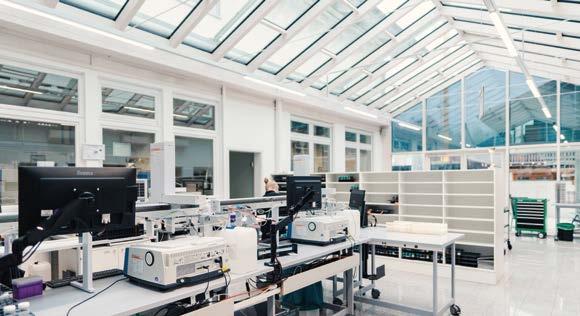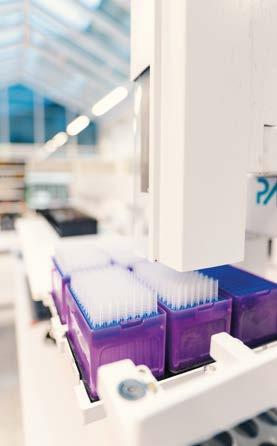
6 minute read
"NO OTHER LABORATORY IS AS INNOVATIVE AS OELCHECK!"
Dr. Thomas Fischer - Scientific Director
"We continue to set new standards in the analysis of lubricants and operating fluids. Dr. Thomas Fischer is the Scientific Director of OELCHECK GmbH and has been with the company since 2004. With his team, he is responsible for monitoring our laboratory equipment and developing new analytical methods.
The OELCHECK laboratory has been accredited with the essential test methods according to DIN EN ISO/IEC 17025:2005 since 2009. In addition, strict corporate standards are used that exceed even ASTM and DIN specifications.

The OELCHECK laboratory covers 2,350 m².
More than 130 test devices are currently in use every day. Among them are: 6 infrared spectrometers | 5 ICP spectrometers | 5 gas chromatographs | 7 particle counters | 20 viscometers with constant temperature baths for determining the viscosity at 40 and 100 °C | 22 titrators for determining acid and base numbers.
MORE THAN 130 TEST DEVICES AND OVER 100 TEST METHODS
Reliable and fast – that's what OELCHECK customers appreciate about our analysis service. To ensure that the high expectations are always met and the constantly increasing number of samples can also be managed in the future, we continue to invest in the equipment of our laboratory. Every year, about ten new devices are added.
In order to measure up to 2,000 samples per day, most of our devices are equipped with autosamplers. These ensure maximum safety and automatically stop the analysis if the values determined are outside the narrow tolerance limits. They facilitate the work of the OELCHECK laboratory staff and significantly accelerate the analysis process.

OUR EXPERTISE IS APPRECIATED INTERNATIONALLY
OELCHECK is involved in national and international research projects and in standardization circles. Whether it's oil sensors, new test methods or the reprocessing of used lubricants, OELCHECK's expertise is valued. OELCHECK was, for example, responsible for the publication of the standards for the BN/ base number (DIN 516391) and the ipH value (ASTM D7946) in 2014. In the ASTM D02 Committee on Petroleum Products, Liquid Fuels, and Lubricants, we contribute to the evaluation of lubricants in service. And as chairman for titration methods we participate in the committee of DIN EN ISO AA 663, the analysis of used oils.

Under the leadership of Michael Linnerer, the staff of the IT department is responsible for the entire hardware landscape, all application programs, the OELCHECK app 4.0, as well as the oelcheck.com website and the LAB.REPORT customer portal. Our tribologists work with in-house evaluation software specifically developed by the IT department to assist in the evaluation of samples.
A central data protection management system was introduced to ensure the protection of customer data and the OELCHECK database with its more than four million lubricant and operating fluid samples and limit values for over 200,000 machines. All live data as well as the data backups are separated from each other via fire compartments. Backups are available both offline and online so that data is not lost in the event of an emergency.
LIMS - THE DIGITAL OELCHECK MANAGER
Our laboratory information and management system combines a large number of different programs that support and control all procedures and processes within the scope of sample analysis. OELCHECK LIMS is an in-house development. It records all analysis results and controls workflows. LIMS provides for a paperless laboratory, optimizes workflows, and also ensures traceability of each sample and sample data.

Michael Linnerer - Head of IT
READY FOR THE NEXT PROJECTS
A test bench for online sensors
Lubricant analysis can help avoid unnecessary oil changes, costly repairs and downtime. However, each analysis is only a snapshot of the past, because a few hours inevitably pass between sampling and the result. In terms of timeliness, online oil sensors are ahead of the game. However, in combination, laboratory analyses and oil sensors are unbeatable in lubricant and plant monitoring.
At present, the values from the two sources are together hardly systematically interpretable. But OELCHECK is putting a lot of effort into finding a solution!
A specially designed test bench enables the evaluation of almost all currently available online oil sensors, which measure viscosity or temperature, for example, or also count particles. We compare the values determined by the sensors with the laboratory analyses. The results are discussed with leading sensor manufacturers. By combining measurements from online oil sensors and laboratory data, our tribologists will be able to make even more precise diagnoses in the future.
Magnetic resonance methods in oil analysis
Nuclear magnetic resonance (NMR) and electron spin resonance (EPR) are two methods established in medicine and materials research. Together with the Karlsruhe Institute of Technology (KIT), the use of NMR in oil analysis was developed. Starting next year, OELCHECK will offer its customers the concentration determination of active phosphorus-based anti-wear additives in oils using phosphorus NMR. Thus, the content as well as the change of these additives in oils can be tracked.
EPR can be used to analyze oils that have a permanent magnetic moment, such as after oxidation processes. The process is not affected by ester base oil components. It also distinguishes between corrosive and abrasive wear of ferromagnetic elements. OELCHECK is currently working with a well-known equipment manufacturer on the possibilities of integrating this technique into routine analysis.
New method - OELCHECK Friction and Wear
The mechanical load capacity of lubricants under mixed friction conditions is realistically determined in the OELCHECK laboratory, e.g. with the FZG tension testing machine, the four-ball apparatus or the Brugger test device. On the basis of comprehensive series tests, we also test whether there are any runtime-dependent differences in wear or friction behavior with approximately the same lubricant composition. In the future, this information, together with the individual values for the concentration of wear-reducing additives in a sample, will be incorporated into OELCHECK's new friction and wear test procedure. It is still in the development phase. But we expect that with its help, we will be able to more accurately diagnose oil changes that are considered necessary due to the diminishing effect of friction and wear reducing additives.
Data suitable for every system
On request, OELCHECK also supplies the data suitable for the customers' individual data processing systems. The transmission takes place via our mobile app, our customer portal LAB.REPORT, an API interface or an FTP server. The data is then automatically imported into the customer's maintenance program.
We are increasingly expanding our new digital service in order to enable us to supply even more customers with data suitable for their own systems in the future.








